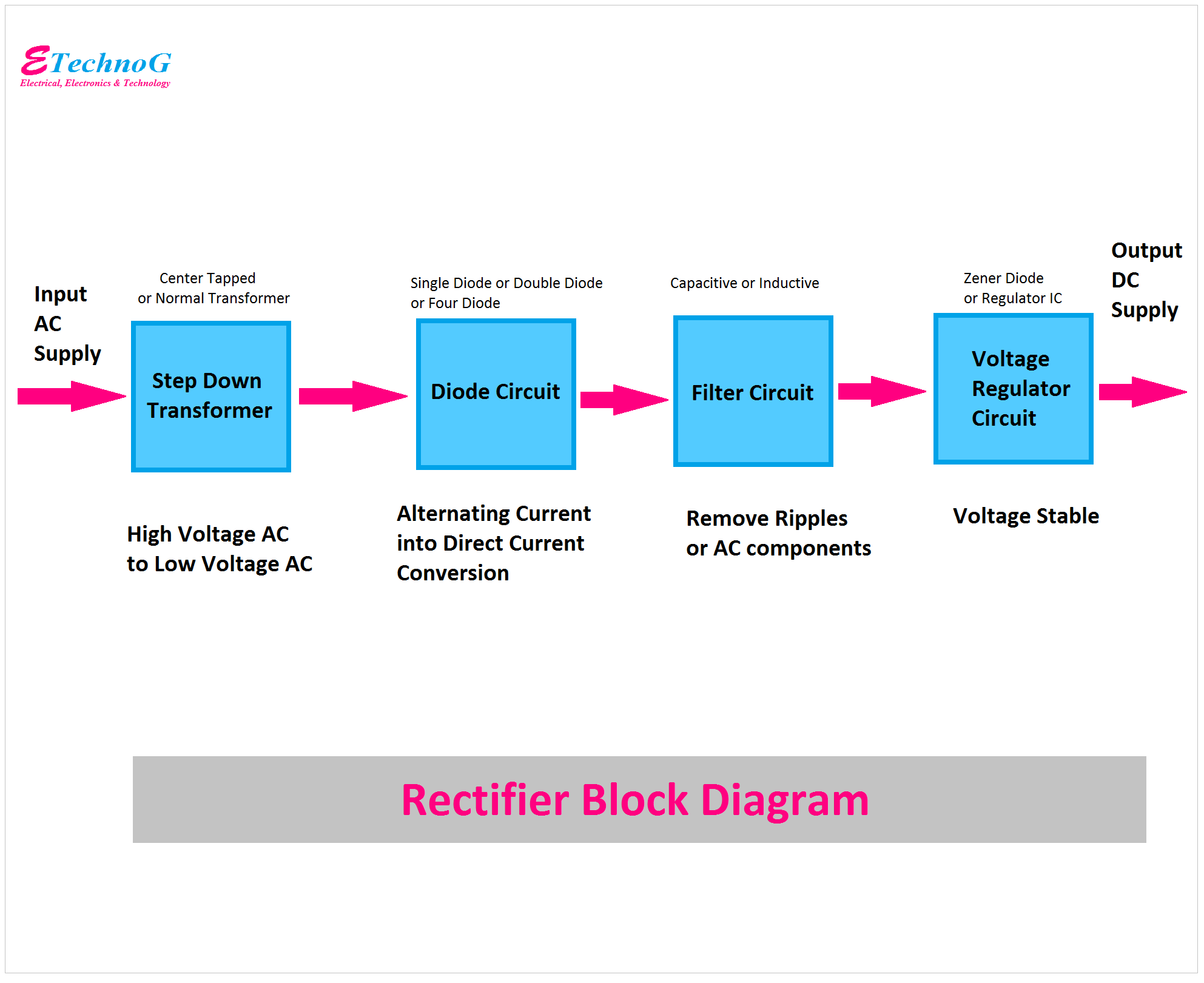What is a Rectifier? Block Diagram, Working Principle
What is a Rectifier?
A rectifier is an electronic device or circuit that converts the Alternating Current(AC) into Direct Current(DC). The main component of a rectifier circuit is the PN Junction Diode. A rectifier circuit may use a single PN junction diode that converts only one cycle or a double PN junction diode (with a center-tapped transformer) or four PN Junction Diodes(for bridge rectifier). Actually, the diode converts the AC into DC. The other parts of the rectifier are also important.
You know we get the electricity in the form of AC as our utility power supply. But there are so many devices, in fact, most of the electronic devices or circuits work with DC supply, not AC. So in this case we required the rectifier circuit. You will see that most of the electronic devices such as televisions, computers, and Music players have a rectifier in their power supply system.
Basically, there are two types of rectifiers available,
- Controlled Rectifier
- Uncontrolled Rectifier
Uncontrolled rectifiers are those where we cannot vary the voltage or other parameters. Uncontrolled rectifiers are generally built with PN junction Diodes. On the other hand, controlled rectifiers are those where we can control the voltage and other parameters. In most of the cases, we use MOSFET, IGBT, or SCR to build a controlled rectifier.
A Simple Rectifier Block Diagram
Here you can see the block diagram of rectifier that was built with four important parts e.g. a step-down transformer, a diode circuit, a filter circuit, and a voltage regulator circuit.
How does a Rectifier Work?
The working principle of a rectifier circuit is very simple.
The transformer is a device that steps up or steps up the voltage. In this case, a step-down transformer is used that steps down the high-voltage AC into low-voltage AC. A rectifier circuit may use a normal step-down transformer or a center-tapped transformer. The normal step-down transformer is used when it is a half-wave rectifier or a bridge rectifier circuit. The center-tapped transformer is used when a full-wave rectifier circuit is built with two PN Junction diodes. Of course, it is costly because of the center-tapped transformer.
Now coming to the diode circuit, that is a very important part of the rectifier. The diode circuit is made of either with a single diode or double diode or four diodes. The half-wave rectifier is built with a single PN junction diode that converts one-half cycle only. The full-wave rectifier circuit with a center-tapped transformer requires two PN junction diodes. The full-wave bridge rectifier circuit is built with four PN junction diodes. The bridge rectifier is the most efficient among all the other types of rectifiers and nowadays it is mostly used.
The main purpose of the filter circuit is to remove the ripple or AC components from the output of the diode circuit. The diode circuit converts alternating current(AC) into Direct Current(DC) but it is not in pure form. So to make the output DC pure, the filter circuit is used. The filter circuit may be inductive(built with only inductors in series) or capacitive(built with only capacitors in parallel) or Inductive-Capacitive(built with both inductors and capacitors).
The main objective of using a voltage regulator circuit is to keep the output voltage level constant even when the input voltage or output load fluctuates or changes. Generally, a Zener diode is connected in parallel with the reverse for voltage regulation. Or the voltage regulator ICs such as IC 7805, IC 7812, and IC 7824 are used for voltage regulation.
Rectifier Applications
Rectifiers are used in charger circuits, power supply modules, SMPS, electronic devices, home appliances, musical instruments, display devices, etc.
Read Also:

